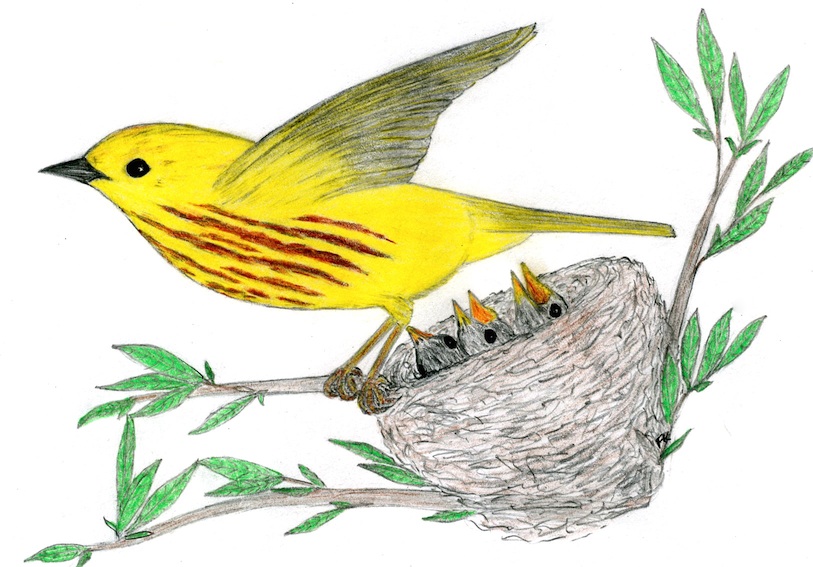A few birds from the Yukon-Kuskokwim Delta.
Browse the glossary using this index
Special | A | B | C | D | E | F | G | H | I | J | K | L | M | N | O
P | Q | R | S | T | U | V | W | X | Y | Z | ALL
Y |
|---|
Yellow Warbler:Yellow Warbler Ciivcivciuk Oh what a beauty this little bird is. If you're traveling close to the edge of a river or creek or marsh, you may see him darting around in the willows and alders. If you do, quick grab your binocs and focus on him for a moment, and you'll see the male's vivid golden jacket lined with rusty-red chest streaks. The female is the same bright yellow, but without the streaking. If it's May or June, watch them further, and you may see some interesting courtship behavior. The male might be doing a little flutter-dance in the air to try to attract the favor of a potential mate watching in the branches of a nearby tree. He most assuredly will be singing at the top of his lungs something like: sweet, sweet, sweet, I'm so sweet, or a variation on that theme. By the way, that's what the name ciivcivciuk is all about in Yupik, which indicates it's one of those onomatopoeic names I've already mentioned in other articles. Ciiv, civ, ciuk is the counterpart of the English sweet, sweet, sweet, but there's something more. Civ also seems to relate to the color yellow. To top it all off, for a couple of days or so the male races around after the female as though his life depended on it, something that reminds me of how boys pursue girls among us humans. Actually the lives of future generations of Yellow warblers do depend on this spirited chase, since it ends in the mating of the two birds, and a family bond that lasts from nest building till the young are reared and fledged about a month and a half later. The nest is a remarkable little thing: cup-shaped, compact, strong, neat and made of grass, pieces of bark and dried weeds, and lined with fur and plant down. The female builds it by herself, although the male accompanies the female to the nest every time she carries material to it, and sometimes pitches in to help her. She has been known to filch a few strands of nesting material from a neighbor who may be off doing some shopping for her own nest. When the nest is ready, the mother bird lays between 2-6 greenish- white, brown-speckled eggs and broods them for 11-12 days. While his mate is on the nest he feeds her their usual fare: caterpillars, mosquitoes, mayflies, moths, beetles, spiders and maybe even a few berries. All of this translates into heat through her brood patch and finally into little blind babies that soon try to eat their parents out of house and home. Then it takes both parents working full time 24 hours a day for 9-12 days to provide the nestlings with sufficient high quality protein to allow them to quickly grow big and strong enough to stand on the edge of their nest and take a leap of faith into thin air. Finally they fly up into what must at first seem a dizzying vault of space filled with all sorts of dangerous impediments like branches, frondy tree trunks, lurking goshawks and gawking birdwatchers. It's no wonder that the mortality rate is so high among fledgling birds. Eventually, by July, the fledglings are on their own, and by August they are just about ready to follow the adult birds in their migration south. It's interesting that in Canada and parts of the U.S. where cowbirds exist, Yellow warblers are often parasitized by these much bigger birds. Cowbirds do this by laying eggs in the warbler's nest, expecting the warbler to raise the young with its own. But the Yellow warbler recognizes the bad eggs right away and builds another layer on top of its nest to make sure the cowbird eggs don't hatch; then she lays a new clutch of her own eggs. In one case a cowbird returned five times to lay eggs in a Yellow warbler nest, and the warbler built six layers of nest floors to cover up the cowbird eggs. Back to names. There are more Yupik names for this bird, all of them being a version of cungakcuarnaq, meaning something like, "bile colored (greenish-yellow) little thing." The scientific name, Dendroica petechia, means "red-spotted tree dweller." The common English name is self-explanatory and, as in Yupik, there are several other names that are variations on the same theme, yellow: Blue-eyed yellow warbler, Golden warbler, Summer warbler, Summer yellowbird, Wild canary, Yellowbird, Yellow poll and Yellow titmouse.  |



